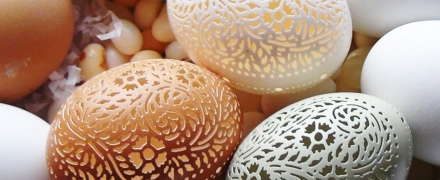open 10 am - 7 pm
laboratory is closed
Eggshell for Jewelers

All of us from childhood are familiar with crafts made from eggshells - painted balls from empty eggs and fragments, on which they tried to cut out unpretentious patterns. Of course, eggshell carving is a whole kind of art, unfortunately, not very common in our time. But what does this occupation have to do with jewelers, you ask? And we will answer - the most direct! And then we will send you to the museums of the Hermitage or the Moscow Kremlin. This is where you can always see eggshell jewelry masterpieces. True, not the shells of eggs of quails, hazel grouses, chickens, ducks, geese and other small birds, as well as snakes, turtles, etc., but from ostrich eggs. Their eggs, both in size and in shell thickness, are quite suitable for making dishes in jewelry design - bowls and goblets. True, the dishes exhibited in museums date back to times past, when porcelain was worth its weight in gold and the shell of a nautilus, or the shell of ostrich eggs, was perceived as a cheaper, but still rare, capable of surprising, replacement for imported porcelain. But what about in our time? Nowadays, souvenirs are also made from the shell of ostrich eggs, but such dishes are rare in jewelry, but still exist, and not only from ostrich shells. We were shown a goblet made from the shell of a fossilized dinosaur egg. To the remark about vandalism, an answer was given about the initially found fragment of an egg with a partially preserved “pink” of the egg, from which the goblet was made. So, millions of years after extinction, egg-laying fossils do not cease to be a source of eggs, not only for researchers and collectors.
В геммологической практике бывают весьма увлекательные случаи с диагностикой ювелирных вставок
Но помимо редкости цвета и высокой стоимости таких камней, многие розовые камни выделяются одной замечательной особенностью – они проявляют плеохроизм, то есть в зависимости от положения осмотра камня он может иметь дополнительные оттенки – оранжевый или пурпурный.
Currently, gemstones are produced by two fundamentally different technological methods - the High Pressure - High Temperature method (“HPHT”, High-pressure & High-temperature) and the Chemical Vapor Deposition (“CVD”, Chemical vapor deposition) method. The "HPHT" method is the most tested classical synthesis method, which can be used both carbon deposition on diamond from flux melts and catalytic reactions. In "CVD" synthesis, diamond growth occurs on a seed during carbon deposition mainly from a gaseous medium at relatively low temperatures and pressures.
Jewelry and precious stones are just such a category of goods, when buying which you need to pay attention to many criteria.
Sogdianite is a rather rare mineral and more often it can be found as a collection material (moreover, in systematic collections), and it is extremely rare in jewelry.






